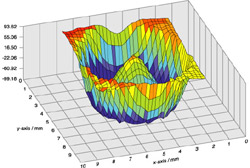 |
 |
Wavefront Analyzers: are used to map "aberrations" in the eye. Several types of visual imperfections, referred to as lower- and higher- order aberrations, exist within the eye and can affect both visual acuity and the quality of vision.
To date, only lower-order aberrations such as myopia, hyperopia, and astigmatism could be measured and treated. But these do not account for all potential vision imperfections. Higher-order aberrations can also have a significant impact on one's quality of vision and are often linked to visual glare and halos that may cause night vision problems. Higher-order aberrations cannot adequately be corrected with glasses, contact lenses, or conventional LASIK treatments but can now be corrected with IntraLASIK procedures.
The wavefront analyzer maps both lower and higher-order aberrations by projecting waves of light into a patient's eye and mapping the waves that bounce back. By comparing the patient's wavefront with a model of perfect vision, doctors are able to create a personalized 3D map of the exact corneal reshaping needed for each patient to address both lower and higher-order aberrations. To create a "customized" LASIK procedure, the map is then electronically transmitted to the laser, enabling the surgeon to address the patient's unique visual requirments. (American Optometric Association News, Vol. 41, No. 19, 4/7.03).
|